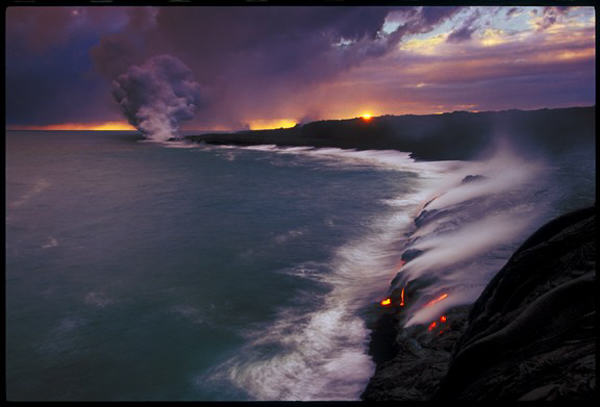Giant Summit Craters And Lava Provide Exciting Viewing
The world’s most active volcano is Kilauea Volcano on the Big Island in Hawaii Volcanoes National Park.
Seeing the lava erupting from Kilauea Volcano is the highlight of any Hawaiian vacation. The good news is that Kilauea has been erupting almost continuously for nearly thirty years!
The volcano is huge, covering some 600 square miles, and its lava flows have destroyed more than 200 homes in recent decades. Kilauea’s continuous flow of the lava into the sea has also made the island bigger by more than 10 acres.
Planning a trip to the Big Island to see the volcano? Stay nearby in one of our Hilo vacation rentals.
Visitors can drive to a point along the coast where they can park and then walk to a viewing area to see the place where the hot lava enters the sea and sends up giant plumes of steaming gas. This process also creates the black sand that washes up on the nearby black sand beaches.
The Volcano’s Summit
While the active lava flows are better seen by driving near the coast, the drive to the summit is equally astounding. At the top is a giant caldera nearly three miles across and within it is Halemaumau Crater. From the Volcano House on the crater rim you can enjoy a snack and look out the windows right down into the steaming abyss.
The summit Kilauea is said to be where Pele, the goddess of fire and volcanoes, protects her sacred fires. You can drive around the summit crater on Crater Rim Drive and gaze at active steam vents and huge pit craters. You can also walk through a giant lava tunnel known as Thurston Lava Tube.
Chain of Craters Road
Descending from the summit to the sea, Chain of Craters Road passes by some major petroglyph fields where etchings were carved into rocks in ancient times. One of the biggest of these areas is known as Puu Loa Petroglyph Area.
Hikes Atop Kilauea Volcano
If you want a moderately strenuous hike at the summit of Kilauea Volcano try the Kilauea Iki Trail, a 5-mile hike that goes down into Kilauea Iki crater. This is a great way to really experience what it is like to stand inside a giant volcanic crater.
Other good hikes include the 11-mile Crater Rim Trail and the 6.4 mile Halemaumau Trail, both in the summit area. The more difficult Napau-Kalapana Trail descends down onto the volcano’s East Rift Zone where the Puu Oo Vent is erupting.
Though much of the summit area is a rocky and desolate volcanic landscape, other areas are thick with plant life including the red blossomed ohia lehua trees and giant tree ferns.
The Visitor Center and Volcano House
Atop the summit of Kilauea Volcano is an informative Visitor Center (808-985-6000) that is open daily. Nearby is the Volcano House Hotel and Restaurant (808-967-7321), a historic structure where there is always a fire burning in the living room fireplace and you can gaze out over the summit area. The Volcano Art Center nearby allows you to see local arts and crafts.
A second visitor center in the summit area is called Jaggar Museum and includes educational volcano exhibits and a great viewing area with binoculars that allow you to view summit areas. You can also learn the difference between pahoehoe lava (smooth lava) and aa lava (rough, jagged lava).
If you are interested in Hawaii volcanoes you can contact the Hawaiian Volcano Observatory which sponsors educational programs and also has live webcams.

